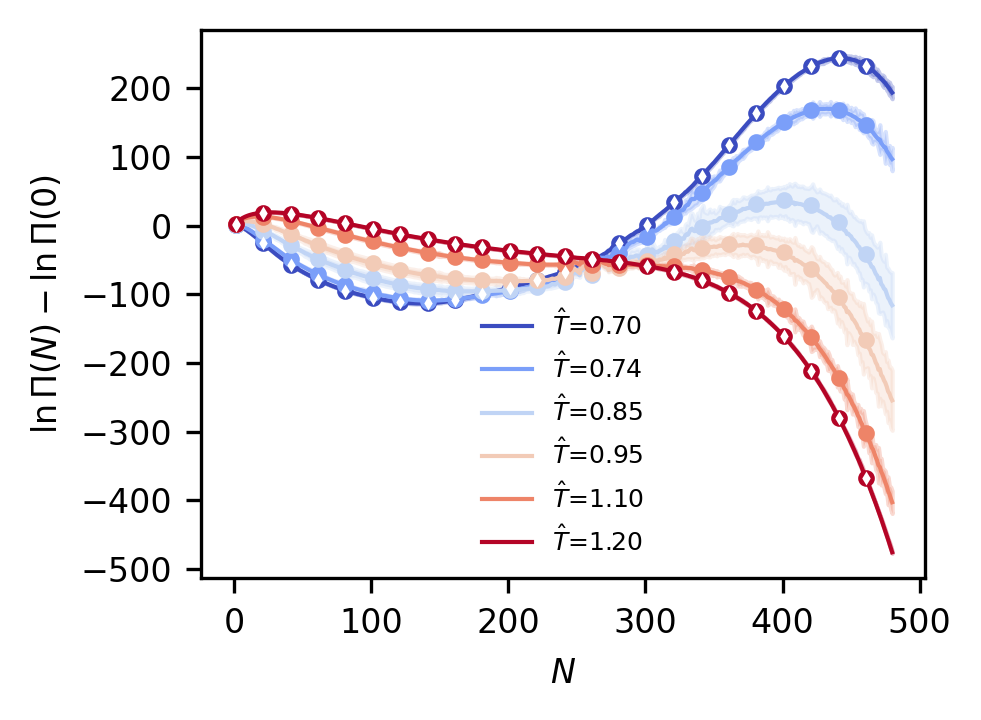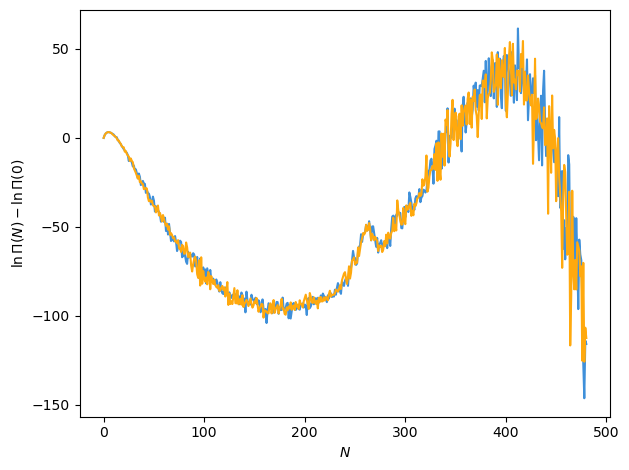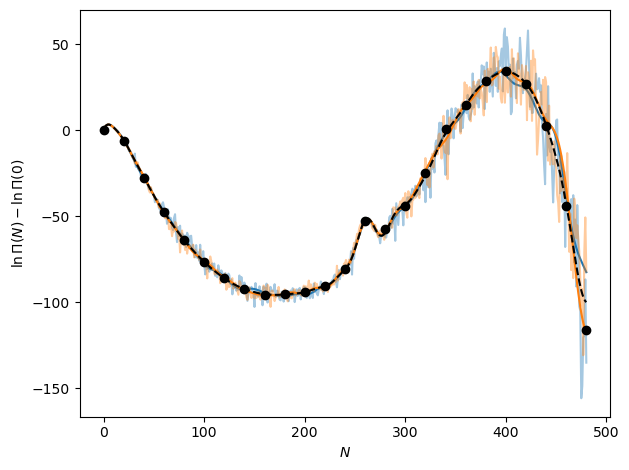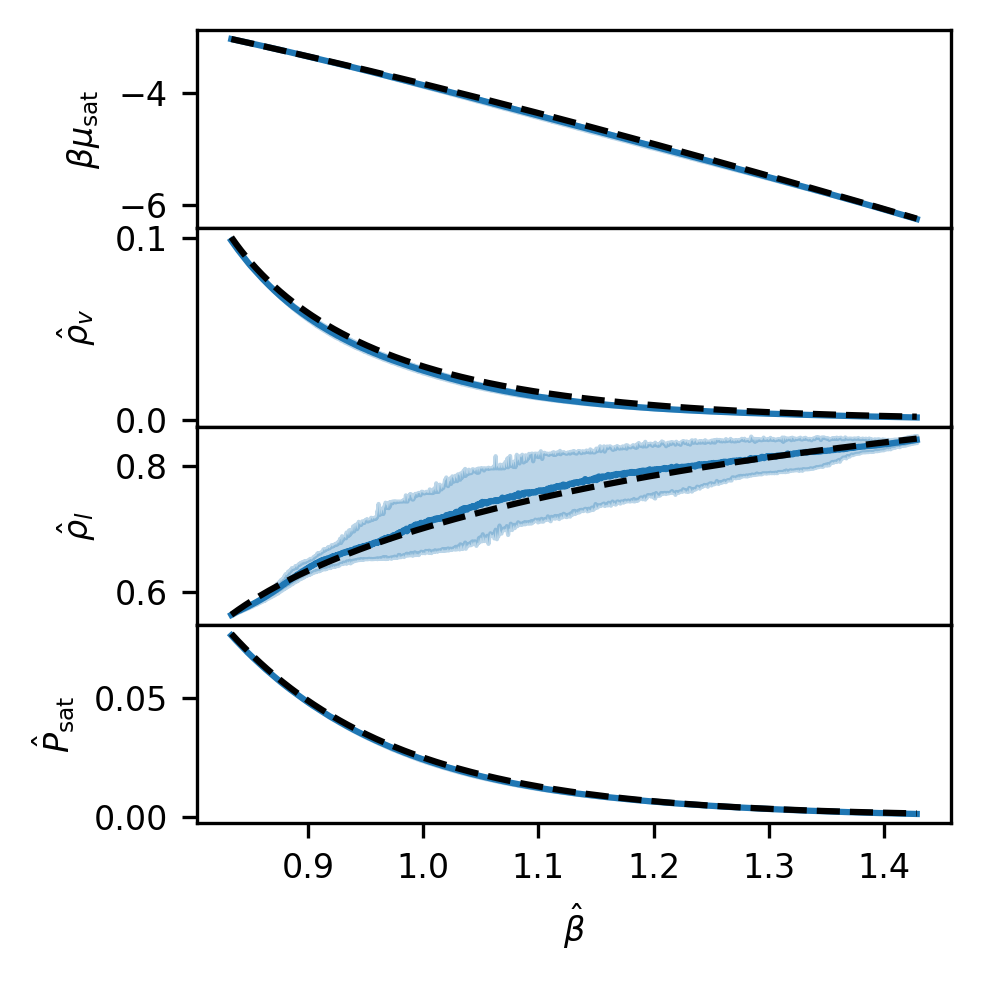Lennard-Jones macrostate distribution#
In this notebook, we will demonstrate how to build a GPR model for the temperature dependence of a macrostate distribution \(\ln \Pi\), or the free energy as a function of the number of particles for a Lennard-Jones (LJ) fluid. All data will be drawn from the Standard Reference Simulation Database, which for convenience is found within the directory “SRS_data.”
import glob
import os
from typing import Optional
import matplotlib.pyplot as plt
import numpy as np
import xarray as xr
import thermoextrap
from thermoextrap.gpr_active import active_utils
Preliminaries#
We start by defining the data directory, also pulling saturation properties from the SRS database.
base_dir = "SRS_data"
raw_dat = np.loadtxt("SRS_data/SRS_LJ_VLE_data.txt")
raw_beta = 1.0 / raw_dat[::-1, 0]
raw_psat = raw_dat[::-1, 5]
raw_dens = raw_dat[::-1, [1, 3]]
raw_lnz = raw_dat[::-1, -2]
It will be useful to have a function to load \(\ln \Pi\) data (i.e., the free energy along \(N\), the number of particles) from a file. This is reproduced from the function load_lnPi_info in run_LJ_lnPi.py. Specifically, provided a temperature and a reference chemical potential, the macrostate distribution and energy moments are returned in a dictionary.
# Define activities for simulations (could also easily do with dictionary, but whatever works)
def get_sim_activity(Tr) -> Optional[float]:
if Tr == 0.700:
return -6.250
if Tr in {0.73, 0.74}:
return -5.500
if Tr == 0.770:
return -5.800
if Tr == 0.850:
return -4.800
if Tr == 0.950:
return -4.100
if Tr == 1.100:
return -3.380
if Tr == 1.200:
return -3.000
return None
def load_lnPi_info(Tr, ref_mu=-4.0, run_num=None, N_cutoff=481):
file_prefix = "{}/lj.t{}.n12m6.v512.rc3.b.r".format(
base_dir,
str(f"{Tr:1.2f}").replace(".", ""),
)
U_moms = np.array(
[
np.loadtxt(f)[:N_cutoff]
for f in sorted(glob.glob(f"{file_prefix}*.energy.dat"))
]
)
# For first column of U information (which is currently N), set to ones, which is zeroth moment
U_moms[:, :, 0] = np.ones(U_moms.shape[:-1])
lnPis = np.array(
[
np.loadtxt(f)[:N_cutoff, 1]
for f in sorted(glob.glob(f"{file_prefix}*.lnpi.dat"))
]
)
N_vals = np.array(
[
np.loadtxt(f)[:N_cutoff, 0]
for f in sorted(glob.glob(f"{file_prefix}*.lnpi.dat"))
]
)
mu = Tr * get_sim_activity(
Tr
) # Tr is kB*T/eps, activity is mu/kB*T, so getting mu/eps
# Convert to x_arrays with proper labeling
U_moms = xr.DataArray(U_moms, dims=["rec", "n", "umom"])
# For lnPi, adjust to a reference mu value
# And subtract off N=0 bin
lnPis = lnPis + (
(1.0 / Tr) * (ref_mu - mu) * N_vals
) # Multiply by 1/Tr since want beta*mu
lnPis = lnPis - lnPis[:, :1]
lnPis = xr.DataArray(lnPis, dims=["rec", "n"])
# For mu need to add extra axis called comp
ref_mu = xr.DataArray(ref_mu * np.ones((U_moms.shape[0], 1)), dims=["rec", "comp"])
return {
"energy": U_moms,
"lnPi": lnPis,
"mu": ref_mu,
"mu_sim": mu,
"beta": 1.0 / Tr,
}
GPR model of \(\ln \Pi\) variations with temperature#
Creating a GPR model for a macrostate distribution is only slightly more difficult than creating a model for any vector-valued observable. For any GPR model, it is typically enough to have a list of ExtrapModel objects representing observables at a given thermodynamic state. The active_utils.create_GPR() function will automatically handle scalar or vector observables, which includes macrostate distributions.
The difficulty with macrostate distributions is that it is only meaningful to extrapolate their relative values in reference to one bin. This is because simulations to calculate them typically only produce relative free energies with the absolute value of any bin unknown due to lack of knowledge of the probability normalization constant, or the partition function. Typically, the reference used is the \(N=0\) particle number bin. The \(N=0\) value of \(\ln \Pi\) will be a constant and is typically set to zero, serving as a reference for the rest of the distribution. This means that even across multiple independent simulations, or temperatures, the \(N=0\) bin will remain zero. Such constant values cause numerical problems for a GPR model since for this specific bin the variance in the data will be zero, which upon whitening (dividing by the standard deviation) yields infinity. To avoid this, we can simply model all other bins with the GPR model, keeping the \(N=0\) bin at zero. However, this means that we need to slightly modify the ExtrapModel object associated with an \(\ln \Pi\) distribution.
To do this, we note that the active_utils.create_GPR() function accepts either a list of ExtrapModel objects representing states, or a list of callables that reutnr the information needed for training a GPR model: the input locations (reciprocal temperatures and derivative orders), output data to train on (\(\ln \Pi\) values), and the noise covariance matrix associated with the output data. As described in our paper, the noise covariance matrix treats each bin independently, meaning that it is more compact to represent each bin and temperature as having its own covariance matrix between derivative data.
All of this is a fair amount of work, which is why there is a utility function active_utils.input_GP_from_state() that takes an thermoextrap.models.ExtrapModel object and extracts the necessary inputs to train a GPR. Since we have a unique case here, we will need to effectively re-do most of what happens in this function, but exclude the \(N=0\) bin.
First, we create a special class, the only purpose of which is to provide a callable that returns the necessary data at a given temperature.
class StatelnPi:
"""Example class."""
def __init__(self, x, y, cov) -> None:
self.x = x
self.y = y
self.cov = cov
def __call__(self):
return self.x, self.y, self.cov
Next, we need to define our reference temperatures, the simulation activities at those temperatures, and load in the data. For our reference chemical potential, which is arbitrary but must be the same as we change temperature, we will choose the average between the most extreme simulations.
ref_T = [0.7, 1.2] # reduced temperatures
ref_activities = [
get_sim_activity(t) for t in ref_T
] # From SRS database - see function above
ref_mu = np.average([a * t for (a, t) in zip(ref_T, ref_activities)])
lnpi_info = [load_lnPi_info(t, ref_mu=ref_mu) for t in ref_T]
For each temperature, we need to create an ExtrapModel object. This will involve creating a specific metadata callback for \(\ln \Pi\), as well as a data object (see data) based on the information collected in lnpi_info.
lnpi_extrap_objects = []
for info in lnpi_info:
meta_lnpi = thermoextrap.lnpi.lnPiDataCallback(
info["lnPi"],
info["mu"],
dims_n=["n"],
dims_comp="comp",
)
data_lnpi = thermoextrap.DataCentralMoments.from_ave_raw(
u=info["energy"],
xu=None,
x_is_u=True,
central=True,
meta=meta_lnpi,
)
lnpi_extrap_objects.append(
thermoextrap.lnpi.factory_extrapmodel_lnPi(beta=info["beta"], data=data_lnpi)
)
Next we need to extract only the information we want to pass to the GPR model for training. This involves accessing temperatures, derivatives, and covariances from our ExtrapModel objects. Note that statistics on derivatives, like covariances, will be computed over multiple independent simulation runs, each generating an estimate of the full \(\ln \Pi\) distribution.
lnpi_states = []
for i, obj in enumerate(lnpi_extrap_objects):
# Get maximum derivative order
d_o = lnpi_info[i]["energy"].sizes["umom"] - 1
# Find reciprocal temperature for this state, pairing with derivative orders
alphas = obj.alpha0 * np.ones((d_o + 1, 1))
x_data = np.concatenate([alphas, np.arange(d_o + 1)[:, None]], axis=1)
# Get derivatives, both the means across independent simulations, and all independent results
derivs = obj.derivs(norm=False, order=d_o).mean("rec")
derivs = derivs.isel(n=slice(1, None)).values
resamp_derivs = obj.derivs(norm=False, order=d_o)
resamp_derivs = resamp_derivs.isel(n=slice(1, None)).values
y_data = derivs
# Compute the covariance matrix between derivatives
cov_data = []
for k in range(resamp_derivs.shape[-1]):
cov_data.append(np.cov(resamp_derivs[..., k]))
cov_data = np.array(cov_data)
# Create a StatelnPi object storing the GPR input information
lnpi_states.append(StatelnPi(x_data, y_data, cov_data))
We can now create our GPR model.
gp_model = active_utils.create_GPR(lnpi_states)
Metal device set to: Apple M2
Looking at the results of the optimization over parameters…
gp_model
| name | class | transform | prior | trainable | shape | dtype | value |
|---|---|---|---|---|---|---|---|
| HeteroscedasticGPR.kernel.kernel.var | Parameter | Softplus | True | () | float64 | 5.54628 | |
| HeteroscedasticGPR.kernel.kernel.l | Parameter | Softplus | True | () | float64 | 0.496656 | |
| HeteroscedasticGPR.likelihood.power_scale | Parameter | Softplus | True | () | float64 | 3.40188 | |
| HeteroscedasticGPR.likelihood.power_add | Parameter | Identity | False | () | float64 | 0 |
Finally, we can plot the results, testing a number of temperatures that we have data for from the SRS database. The result should be Figure 9 from the paper.
# Set up array of temperatures for which we have data and can compare to our model
test_T = np.array([0.70, 0.74, 0.85, 0.95, 1.10, 1.20])
test_beta = 1.0 / test_T
# Make predictions using the model
gp_mu, gp_var = gp_model.predict_f(np.vstack([test_beta, np.zeros_like(test_beta)]).T)
gp_mu = gp_mu.numpy()
gp_var = gp_var.numpy()
gp_std = np.sqrt(gp_var)
# Add N=0 bin back in, setting it to zero
gp_mu = np.concatenate([np.zeros((gp_mu.shape[0], 1)), gp_mu], axis=-1)
gp_var = np.concatenate([np.zeros((gp_var.shape[0], 1)), gp_var], axis=-1)
gp_std = np.concatenate([np.zeros((gp_std.shape[0], 1)), gp_std], axis=-1)
N_vals = np.arange(gp_mu.shape[1])
tColors = plt.cm.coolwarm(np.linspace(0.0, 1.0, len(test_T)))
fig, ax = plt.subplots(figsize=(3.37, 2.5), dpi=300)
for i in range(len(test_T)):
# Plot predictions at each temperature, both mean and 95% confidence intervals
this_pred = gp_mu[i, :]
ax.fill_between(
N_vals,
this_pred - 2.0 * gp_std[i, :],
this_pred + 2.0 * gp_std[i, :],
color=tColors[i],
alpha=0.3,
)
ax.plot(
N_vals,
this_pred,
linewidth=1.0,
color=tColors[i],
label=rf"$\hat{{T}}$={test_T[i]:1.2f}",
)
# Plot the reference data at this temperature, adjusting to the same chemical potential
this_true = np.average(load_lnPi_info(test_T[i], ref_mu=ref_mu)["lnPi"], axis=0)
ax.plot(N_vals[1::20], this_true[1::20], "o", color=tColors[i], ms=3.0)
# Below loop plots a subset of the data points actually used for training to indicate those temperatures
max_order = int(np.max(gp_model.data[0][:, 1]))
for i in range(len(ref_T)):
this_ref = gp_model.data[1][i * (max_order + 1), :] * gp_model.scale_fac
ax.plot(N_vals[1::20], this_ref[::20], "dw", ms=1.0)
ax.tick_params(axis="both", labelsize=8)
ax.legend(fontsize=6, frameon=False)
ax.set_xlabel(r"$N$", fontsize=8)
ax.set_ylabel(r"$\ln \Pi (N) - \ln \Pi (0)$", fontsize=8)
fig.tight_layout()
plt.show()

Saturation properties#
Saturation properties are more difficult to determine based on the macrostate distributions predicted by the GPR model. The reason lies in the assumption that each particle number bin can be treated as independent, only affecting each other in that the same kernel and likelihood model are used and hence the optimal parameters are determined by considering all bins simultaneously. Otherwise, though, the produced probability distribution for \(\ln \Pi\) at a new temperature is a produce of independent Gaussians, one for each bin. It turns out this works quite well to capture the temperature dependence, but does not work well when sampling new values. For instance, let’s just try sampling two draws from the GPR-predicted distribution at \(T_\mathrm{r} = 0.85\) and look at what we get for the macrostate distribution.
rng = np.random.default_rng()
rand_draw = rng.normal(loc=gp_mu[2, :], scale=gp_std[2, :], size=(2, gp_mu.shape[1]))
fig, ax = plt.subplots()
ax.plot(N_vals, rand_draw.T)
ax.set_xlabel(r"$N$")
ax.set_ylabel(r"$\ln \Pi (N) - \ln \Pi (0)$")
fig.tight_layout()
plt.show()

The problem is that there are clearly correlations between the particle number bins that are not captured when sampling from this distribution. In other words, we’ve just sampled with a diagonal covariance matrix, effectively, and we would really like to sample with covariances, or non-zero off-diagonal terms. The further we are from reference temperatures used for training, the more noisy the draws will become due to larger uncertainties associated with those GPR predictions.
To remedy this, we can learn the correlations in \(N\) using a new GP model. Such a model will be simple and easy to train because the prediction from the GPR over temperature exactly specifies the means (output values) and our uncertainty in them (their variances, which will compose a diagonal noise covariance matrix). All we need to learn are the kernel parameters and a we can use a simple likelihood with no optimizable parameters.
# Create data for GP model over N dimension
# No derivatives here, so zeros for second column
x_input = np.vstack([N_vals[1:], np.zeros(N_vals.shape[0] - 1)]).T
y_input = np.reshape(gp_mu[2, :], (-1, 1))[1:, :]
cov_input = np.diag(np.squeeze(gp_var[2, :])[1:])
# Note that ignoring modeling of N=0 bin... will be zero no matter what, with std of 0
# That can throw off matrix, so ignore for modeling and sampling purposes
# Create model, but make sure to set power scale to zero and constrain it
# Don't want to modify/learn anything about covariance matrix here
particle_bin_gp = active_utils.create_base_GP_model(
(x_input, y_input, cov_input),
likelihood_kwargs={
"p": 0.0,
"transform_p": None,
"constrain_p": True,
},
)
# Train it
active_utils.train_GPR(particle_bin_gp)
And we can take a look at this model…
particle_bin_gp
| name | class | transform | prior | trainable | shape | dtype | value |
|---|---|---|---|---|---|---|---|
| HeteroscedasticGPR.kernel.kernel.var | Parameter | Softplus | True | () | float64 | 0.732302 | |
| HeteroscedasticGPR.kernel.kernel.l | Parameter | Softplus | True | () | float64 | 15.515 | |
| HeteroscedasticGPR.likelihood.power_scale | Parameter | Identity | False | () | float64 | 0 | |
| HeteroscedasticGPR.likelihood.power_add | Parameter | Identity | False | () | float64 | 0 |
Now we can plot the model over the particle number bins with two new draws from it without added noise covariances, seeing that effectively it is smoothly any predictions, adding in correlations between the particle number bins. It turns out, however, that due to the large uncertainty in any of the predicted mean values from the GPR model in temperature, the noise still dominates. This is shown as adding the noise covariance back to the covariance output by the model associated with just the kernel and the correlations over the particle number bins.
# Want the distribution of functions given the provided inputs
# Evaluating at the input locations, so x=x* and want full covariance
particle_bin_pred = particle_bin_gp.predict_f(particle_bin_gp.data[0], full_cov=True)
particle_bin_mean = particle_bin_pred[0][:, 0].numpy()
# And want uncertainty in model plus noise, so add noise covariance to output
particle_bin_cov = np.squeeze(particle_bin_pred[1]) + cov_input
# But also check what it looks like without noise added back in
particle_bin_cov_no_noise = np.squeeze(particle_bin_pred[1])
# Draw random samples from multivariate normal based on GP output
particle_bin_draw = rng.multivariate_normal(
mean=particle_bin_mean, cov=particle_bin_cov, size=2
)
particle_bin_draw_no_noise = rng.multivariate_normal(
mean=particle_bin_mean, cov=particle_bin_cov_no_noise, size=2
)
# Add N=0 bin back in
particle_bin_draw = np.concatenate([np.zeros((2, 1)), particle_bin_draw], axis=-1)
particle_bin_draw_no_noise = np.concatenate(
[np.zeros((2, 1)), particle_bin_draw_no_noise], axis=-1
)
# And plot!
fig, ax = plt.subplots()
for i, color in enumerate(["tab:blue", "tab:orange"]):
ax.plot(N_vals, particle_bin_draw[i, :], color=color, alpha=0.4)
ax.plot(N_vals, particle_bin_draw_no_noise[i, :], color=color)
ax.plot(N_vals[1:], particle_bin_mean, "k--")
ax.plot(N_vals[::20], gp_mu[2, ::20], "ko")
ax.set_xlabel(r"$N$")
ax.set_ylabel(r"$\ln \Pi (N) - \ln \Pi (0)$")
fig.tight_layout()
plt.show()

Though the noise dominates for this temperature, this will not always be the case and in many cases the learned correlations will in fact be helpful for predicting random changes in a macrostate distribution. At the very least, it is a better probabilistic model for a macrostate distribution, adding in correlations that would not be present in the original prediction from the GPR trained to predict changes with temperature.
Code may be found in run_LJ_lnPi.py (within the example_projects directory) that performs the model fitting above for each new temperature, takes a large number of random draws, and uses each of those stochastically drawn distributions to compute saturation properties with the tmmc-lnpy package. This creates bootstrapped distributions of saturation properties that can be plotted. The results of this procedure, which may be found as code in the example_projects directory, are saved in the file “sat_props_GPR.npz” found in the “SRS_data” directory. To actually run the run_LJ_lnPi.py script found in example_projects used to generate those files, you will also have to install the tmmc-lnpy package via pip install tmmc-lnpy in addition to the thermoextrap environment.
# Load saturation properties
# Should be lnz, density_gas, density_liquid, pressure_gas, pressure_liquid
sat_props = np.load(os.path.expanduser("SRS_data/sat_props_GPR.npz"))
gp_sat_props = sat_props["props"]
gp_sat_props_conf_ints = sat_props["conf_ints"]
# Plot true values versus predicted properties
prop_betas = 1.0 / np.linspace(0.7, 1.2, 1000)
fig, ax = plt.subplots(
gp_sat_props.shape[1] - 1, sharex=True, sharey=False, figsize=(3.37, 3.37), dpi=300
)
for i, prop in enumerate([raw_lnz, raw_dens[:, 0], raw_dens[:, 1], raw_psat]):
ax[i].plot(prop_betas, gp_sat_props[:, i], color="tab:blue")
ax[i].fill_between(
prop_betas,
gp_sat_props_conf_ints[:, 0, i],
gp_sat_props_conf_ints[:, 1, i],
color="tab:blue",
alpha=0.3,
)
ax[i].plot(raw_beta, prop, "k--")
ax[i].tick_params(axis="both", labelsize=8)
ax[-1].set_xlabel(r"$\hat{\beta}$", fontsize=8)
ax[0].set_ylabel(r"$\beta \mu_\mathrm{sat}$", fontsize=8)
ax[1].set_ylabel(r"$\hat{\rho}_v$", fontsize=8)
ax[2].set_ylabel(r"$\hat{\rho}_l$", fontsize=8)
ax[3].set_ylabel(r"$\hat{P}_\mathrm{sat}$", fontsize=8)
fig.tight_layout()
fig.subplots_adjust(hspace=0.0)
plt.show()

This is Figure 10 from our paper.